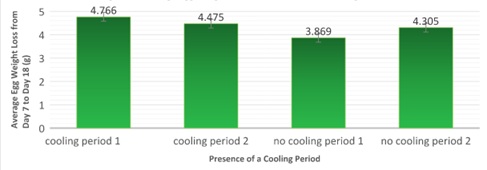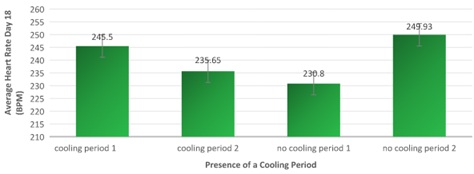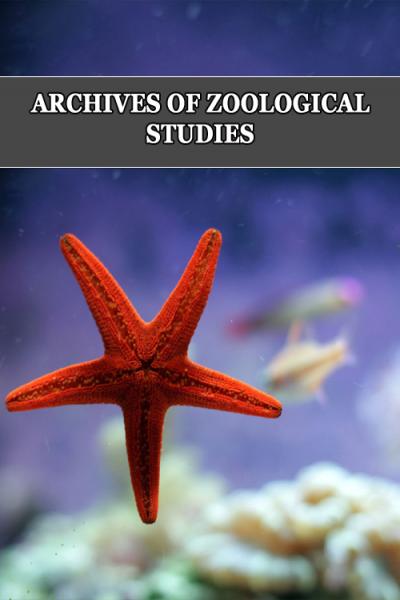
Archives of Zoological Studies Category: Agriculture
Type: Research Article
Cooling Periods Enhance Specific Pathogen Free (Spf) Poultry Egg Hatchability
*Corresponding Author(s):
Cord BrundageDepartment Of Animal And Veterinary Sciences, California State Polytechnic University, Pomona, United States
Tel:+1 9098692078,
Email:cmbrundage@cpp.edu
Received Date: Dec 16, 2019
Accepted Date: Dec 20, 2019
Published Date: Dec 27, 2019
Abstract
A central component of the poultry Aspergillosis vaccine research conducted at Cal Poly Pomona is the successful incubation and hatching of specific pathogen free (SPF) eggs. In an attempt to improve the percentage of SPF poultry eggs that hatched during incubation (hatchability), a simulated natural nesting cooling period was implemented once daily in two of four incubation groups. 159 SPF chicken eggs were acquired by a commercial supplier. Two incubation groups (n = 80) were maintained at a constant temperature of 37.5 C. Two other incubation groups (n = 79) experienced a once daily 60 minute decrease in temperature (21.1°C), simulating the cooling an egg may experience when a hen leaves their nest. Eggs were incubated in a cabinet incubator within the BSL-2 facility and all other incubation parameters were controlled (humidity, temperature, turning interval, etc.). Candling to evaluate egg development occurred after the 1st and before the 3rd week of incubation. Heart rate was evaluated non-invasively before the 3rd week of incubation. The incubation groups without a cooling period had a hatchability rate of 82.5% and 90%, while the hatchability of the two groups with the cooling period was 94.9% and 100% respectively. In the absence of other unknown factors, this evidence suggests that including a daily 60 minute cooling period during incubation increases SPF poultry egg hatchability rates.
INTRODUCTION
Creating the most realistic nesting conditions is essential to ensure a successful hatchability rate. Temperature can have one of the largest impacts on the incubation period. If the temperature deviates from its optimum level of 37°C through 38°C, then post-hatch growth and organ function of the chickens can be impaired [1]. Heat stress can occur to the chick embryos when facing temperatures above 39°C, resulting in high mortality rates and decreased embryonic development due to limited metabolic process by insufficient exchange of oxygen [2,3]. However, research has shown that a temporary drop in temperature from the optimum level can be seen as beneficial, while a permanent change in temperature decreases the hatchability rate immensely [4]. There is limited to no data around the effects of daily cooling periods where temperatures are dropped to room temperature (21.1°C) for a limited time. This experiment sheds light on the effect of a limited cooling period throughout incubation for 60 minutes daily.
The purpose of this study is to optimize the hatchability of SPF chickens in this vaccine testing facility, in order to create an affordable and effective as pergillosis vaccine. This research will also investigate if cooling periods increase hatchability, as they mimic more natural nesting conditions. This study will examine if heart rate or egg weight loss contributes to hatchability. By emplacing cooling periods, it will be determined if there are any negative side effects, such as dysfunctions or disorders. It is hypothesized that the trials with a cooling period will have higher hatchability rates, due to a more accurate simulation of natural nesting.
The purpose of this study is to optimize the hatchability of SPF chickens in this vaccine testing facility, in order to create an affordable and effective as pergillosis vaccine. This research will also investigate if cooling periods increase hatchability, as they mimic more natural nesting conditions. This study will examine if heart rate or egg weight loss contributes to hatchability. By emplacing cooling periods, it will be determined if there are any negative side effects, such as dysfunctions or disorders. It is hypothesized that the trials with a cooling period will have higher hatchability rates, due to a more accurate simulation of natural nesting.
METHODS
The incubation protocol consisted of the 159 SPF chicken eggs being incubated at approximately 37.5°C in an environment with 50-60% humidity, from day 1 to 17. At day 18, the temperature remained the same but the humidity was increased to 65-75% until they hatched on day 21. The increased humidity aids in the chickens’ ability to pip. Throughout the incubation process, the eggs remained in the Brinsea OVA-Easy Advance Series II Incubator. The incubator was set to tilt every 180 minutes up until day 18. The eggs were rotated by hand once a day 90 degrees until day 18 as well. The eggs were rotated to promote embryo growth and to prevent premature adhesion of embryo membranes to the shell. Eggs were candled and weighed after the 1st week and before the 3rd week. Heart rate was also taken on day 18, using the Avitronics Egg Buddy Digital Egg Heart Monitor. Observing heart rate helped with the candling process because eggs in later development stages are difficult to observe movement or indication of growth. Re- candling took place after each candling session if there was any uncertainty with an egg. Culling is an important step in the incubation process. If eggs containing dead embryos are left in the incubator, bacteria may develop and ferment, which could cause an explosion and contamination of the entire clutch of eggs. Culling took place after the two rounds of candling (day 7 and 18) as well as for the eggs that did not hatch (day 23). Euthanasia was used for chicks displaying signs of suffering. Three chicks were euthanized in the first treatment group with a cooling period. One chick exhibited curled toes and could not mobilize normally. This was diagnosed as curled toe paralysis, caused by a B2 deficiency in laying hen. The second chick was resting on its hocks exhibiting, swollen feet and bleeding and bruising at joint. This was diagnosed as slipped tendons, caused by a manganese deficiency in laying hen. The third chick never gained motor skills. This was diagnosed as a neurological issue, due to a vitamin E deficiency in laying hen. None of these signs were present in cooling period treatment group 2, so it is believed deficiencies in the nutrition of the laying hen caused these issues.
RESULTS
Both cooling period treatment groups exhibited the largest amount of egg weight loss towards the end of the incubation period, compared to the other treatment groups (Table 1 & Figure 1).

Figure 1: Average egg weight loss vs. presence of a cooling period.
|
Cooling Period Group 1 |
Cooling Period Group 2 |
No Cooling Period Group 1 |
No Cooling Period Group 2 |
|
|
Average Heart |
245.50 BPM |
235.65 BPM |
230.80 BPM |
249.93 BPM |
|
Hatchability |
94.90% |
100% |
82.50% |
90% |
|
Weight Loss |
4.766g |
4.475g |
3.868g |
4.305g |
There is a statistically significant increase in weight loss in groups with a cooling period compared with those without (p < 0.001). The heart rates of all four groups are shown in Table 1 & Figure 2. There is not a statistically significant difference between the presence of a cooling period and heart rate (p = 0.139). Both groups that received the cooling period had a higher hatchability rate compared to the two groups without (Table 1).
 Figure 2: Average heart rate vs. presence of a cooling period.
Figure 2: Average heart rate vs. presence of a cooling period.DISCUSSIONS
The results support our hypothesis that the treatment groups with the cooling periods would have increased hatchability rates compared to the treatment groups without a cooling period. This may be due to the cooling period stimulating more natural nesting conditions. Several non-domesticated avian species require cooling periods to maintain viability. Poultry have been heavily domesticated and incubated in commercial operations to the point that a cooling period is not required. The improved hatchability in this study may provide evidence of some remnant adaptive advantage still provided by a periodic cooling. There was a significant increase in weight loss in groups with the cooling period. We are unable to identify the specific losses that occurred. The live chick weight of each group did not differ after hatching. This would suggest that the nutritional and or aqueous faction of the egg may be responsible for the significant weight difference. It is also hypothesized that embryos that are intermittently cooled have reduced heat production because of a reduced metabolic rates during the time of exposure to lower temperature, however, when the cooled eggs are returned to normal incubation temperature, compensatory metabolic rate occurs and consequently, higher heat production [5,6]. This in return may lead to a lower amount of nutritional content in the egg. Evaporative loss is unlikely because it has been reported to decrease hatchability rates significantly. Heart rate was also not significantly different between the cooling period and non- cooling period groups. If fluid loss was evident that may also impact the intravascular fluids and cardiovascular system of the embryos. This was again not the case, suggesting that cooling periods may facilitate an increase in chick embryo metabolism and the use of energy stores within the chick. This increased metabolism and/or utilization of egg nutrients could be a positive factor that may explain the improved hatchability and increased weight loss noted in the cooling period groups. Additional studies are needed to identify the mechanisms and physiologic principals at play as well as investigating more specifically how emulating natural conditions impacts hatchability.
REFERENCES
- Lourens A, Van den Brand H, Meijerhof R, Kemp B. (2005) Effect of eggshell temperature during incubation on embryo development, hatchability, and posthatch development. Poult Sci 84: 914-920.
- Ayo JO, Obidi JA, Rekwot PI (2011) Effects of heat stress on the well-being, fertility and hatchability of chickens in the northern Guinea savannah zone of Nigeria: a review. ISRN veterinary science 838606.
- Rahn H, Paganelli CV, Ar A (1974) The avian egg: air cell gas tension, metabolism and incubation time. Respiration Physiology 22: 297-309.
- Nakage ES, Cardozo JP, Pereira GT, Boleli SA (2003). Effect of temperature on incubation period, embryonic mortality, hatch rate, egg water loss and partridge chick weight (Rhynchotus rufescens). Brazilian Journal of Poultry Science 5: 131135.
- Geers R, Michels H, Nackaerts G, Konings F (1983) Metabolism and growth of chickens before and after hatch in relation to incubation temperature. Poultry Sci 62: 1869-1875.
- Kuhn ER, Decuypere E, Colen LM, Michels H (1982) Posthatch growth and development of circadian rhythm for thyroid hormones in chicks incubated at different temperatures. Poult Sci 61: 540-549.
Citation: Markson J, Cord B (2019) Cooling Periods Enhance Specific Pathogen Free (Spf) Poultry Egg Hatchability. Archiv Zool Stud 2: 011.
Copyright: © 2019 Jordan Markson, et al. This is an open-access article distributed under the terms of the Creative Commons Attribution License, which permits unrestricted use, distribution, and reproduction in any medium, provided the original author and source are credited.

Journal Highlights
© 2026, Copyrights Herald Scholarly Open Access. All Rights Reserved!
